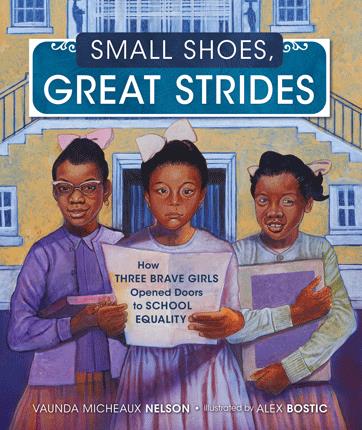| Small shoes, great strides : how three brave girls opened doors to school equality Author: Nelson, Vaunda Micheaux | ||
| Price: $20.98 | ||
Summary:
A powerful true story about three Black girls--Leona Tate, Gail Etienne, and Tessie Prevost--who courageously integrated a New Orleans school on November 14, 1960.
| Illustrator: | Bostic, Alex |
| Accelerated Reader Information: Interest Level: LG Reading Level: 5.70 Points: 1.0 Quiz: 554091 |
Reviews:
School Library Journal (+) (01/01/24)
Booklist (+) (12/01/23)
The Hornbook (+) (00/01/24)
Full Text Reviews:
Booklist - 10/01/2023 *Starred Review* Ten minutes before Ruby Bridges’ legendary (and well-documented) 1960 walk into another New Orleans elementary school, Black six-year-olds Leona Tate, Tessie Prevost, and Gail Etienne integrated the Ninth Ward’s McDonogh No. 19 Public School. With insights from the three changemakers, Coretta Scott King Author Award winner Nelson (The Book Itch, 2015; Let ‘Er Buck! 2019) offers notable specifics about that integration rooted in the innocence of the students’ recollections. Nelson also captures the historic impact of the “McDonogh Three” through their adult reflections on that lonesome yet unifying process and their later school experiences, including unrelenting cruelty they experienced as targets of white bigots. The second half of the book, including extensive back matter, is somewhat text-dense, but this duality extends its reach to upper elementary use. As usual, Nelson does her research and includes interviews with all three women plus the widow of a beloved U.S. Marshal, photographs, and more. Bostic invokes the school’s brown paper window coverings as a moving background for glorious acrylic portraiture featuring violets and purples that summon feminism and the threesome's status as civil rights royalty. Particularly luminous, illustrative details include the textured folds of the girls’ school dresses and the clutch of their hands. A welcome spotlight on the undersung history of three girls whose bravery and endured torment carved a path for generations. - Copyright 2023 Booklist.
School Library Journal - 01/01/2024 Gr 2–4—Ten minutes before Ruby Bridges made her escorted walk into elementary school back on November 14, 1960, Leona Tate, Gail Etienne, and Tessie Prevost entered McDonogh No. 19 Public School in New Orleans. They were first graders, Black, facing protestors, and they counted on members of the U.S. Marshals to keep them safe. Nelson, working closely with Tate, Etienne, and Prevost, who remained lifelong friends, has written the story of that day, accompanied by Bostic's scenes that conjure the era perfectly for young readers. The details are gripping; this was a first grade class of just the three girls and a teacher because the parents of white children removed their own. The windows were covered with brown paper. This lasted an entire school year while the families suffered death threats, harassment, and disruption. They had to change their telephone numbers multiple times. Yet the three girls loved class and their teacher, Miss Meyers; the schoolroom scenes glow like oil paintings. When the girls are transferred, with all other students, to Semmes Elementary, the book becomes bleak; all Black children are bullied by students and teachers alike. The story ends there. Glossary, bibliography, websites, an author's note, and follow-up information about the three women who helped change the course of segregation are all part of the back matter. VERDICT Caution any readers taking this on alone about content; it's brutal, enlightening, hopeful, and realistic. An important piece of history, the book is a treasure and will require classroom discussion.—Kimberly Olson Fakih - Copyright 2024 Publishers Weekly, Library Journal and/or School Library Journal used with permission.



